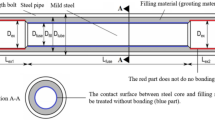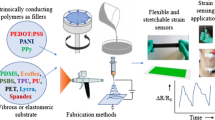Abstract
The nominal stress–strain relationships of industrial rubber materials under multiaxial deformation are essential for precisely determining the constitutive laws of those materials. This paper proposes a new method for precisely estimating the nominal stress–stretch relationships of carbon-black-filled styrene butadiene rubbers (SBRs) under uniaxial tension, pure shear, and equibiaxial tension by using an in-plane biaxial tensile tester. The proposed method employs sheet-shaped rubber samples with notches for the pure-shear and equibiaxial tension tests to mitigate the influence of non-uniform deformation around the clamps. Finite element analysis and biaxial tensile tests were performed to verify the effectiveness of the proposed method. Performance evaluations based on both numerical calculations and experiments revealed that the proposed method enabled the precise calculation of the nominal stress–stretch relationship for uniform deformation from a tensile load and deformation of the reference area defined at the center of the samples.
















Similar content being viewed by others
References
Ogden RW (1997) Non-Linear Elastic Deformations. Dover Publications, New York
Holzapfel G (2000) Nonlinear solid mechanics: a continuum approach for engineering. Wiley, New York
Steinmann P, Hossain M, Possart G (2012) Hyperelastic models for rubber-like materials: consistent tangent operators and suitability for Treloar’s data. Arch Appl Mech 82(9):1183–1217
Hossain M, Steinmann P (2013) More hyperelastic models for rubber-like materials: consistent tangent operators and comparative study. J Mech Behav Mater 22:27–50
Reuge N, Schmidt F, Maoult YL, Rachik M, Abbé F (2001) Elastomer biaxial characterization using bubble inflation technique. I: Experimental investigations Polym Eng Sci 41(3):522–531
Rachik M, Schmidt F, Reuge N, Maoult YL, Abbeé F (2001) Elastomer biaxial characterization using bubble inflation technique II: Numerical investigation of some constitutive models. Polym Eng Sci 41(3):532–541
Sasso M, Palmieri G, Chiappini G, Amodio D (2008) Characterization of hyperelastic rubber-like materials by biaxial and uniaxial stretching tests based on optical methods. Polym Test 27(8):995–1004
Sasso M, Chiappini G, Rossi M, Cortese L, Mancini E (2013) Visco-hyper-pseudo-elastic characterization of a fluoro-silicone rubber. Exp Mech. doi:10.1007/s11340-013-9807-5
Zhao X, Berwick ZC, Krieger JF, Chen H, Chambers S, Kassab GS (2013) Novel design of cruciform specimens for planar biaxial testing of soft materials. Exp Mech. doi:10.1007/s11340-013-9808-4
Woo CS, Kim WD, Park HS (2011) Finite element analysis and design of rubber specimen for mechanical test. Proceedings of the 7th European conference on constitutive models for rubber (ECCMR):439–443
Treloar L (1944) Strains in an inflated rubber sheet, and the mechanism of bursting. Rubb Chem Technol 17(4):957–967
Tada T, Urayama K, Mabuchi T, Muraoka K, Takigawa T (2010) Nonlinear stress relaxation of carbon black-filled rubber vulcanizates under various types of deformation. J Polym Sci, Part B: Polym Phys 48(12):1380–1387
Kawabata S, Matsuda M, Tei K, Kawai H (1981) Experimental survey of the strain energy density function of isoprene rubber vulcanizate. Macromolecules 14(1):154–162
Blatz P, Ko W (1962) Application of finite elastic theory to the deformation of rubbery materials. J Rheol 6(1):223–252
Batra RC, Mueller I, Strehlow P (2005) Treloar’s biaxial tests and Kearsley’s bifurcation in rubber sheets. Math and Mech Solids 10(6):705–713
Fujikawa M, Kamimura T, Makabe C (2010) Simple calculation technique of nominal stress/strain in biaxial tensile testing of rubber materials. Jap Soc Exp Mech 10(1):104–109 (in Japanese)
Higuchi T, Tsutsui S, Yamamura M (2001) Simplex crossover for real-coded genetic algorithms. J Jap Soc Artif Intell 16:147–155 (in Japanese)
Author information
Authors and Affiliations
Corresponding author
Appendix A In-Plane Biaxial Tension Test for a Conventional Test Piece and Identification of Material Constants
Appendix A In-Plane Biaxial Tension Test for a Conventional Test Piece and Identification of Material Constants
The results obtained for the uniaxial-tension, pure-shear, and equibiaxial-tension tests with a conventional test piece are shown. The shape and dimensions of the test piece and the experimental method are the same as those shown and described in Sections 2 and 4, respectively. Fig. 16 shows the nominal stress–stretch relationship of SBR-CB10 and SBR-CB20 and the fitted curves obtained using the Ogden model. The fitted curves do not agree with those obtained in the experiment. The validity of the identified material constants is verified in Section 4.3.
Rights and permissions
About this article
Cite this article
Fujikawa, M., Maeda, N., Yamabe, J. et al. Determining Stress–Strain in Rubber with In-Plane Biaxial Tensile Tester. Exp Mech 54, 1639–1649 (2014). https://doi.org/10.1007/s11340-014-9942-7
Received:
Accepted:
Published:
Issue Date:
DOI: https://doi.org/10.1007/s11340-014-9942-7




